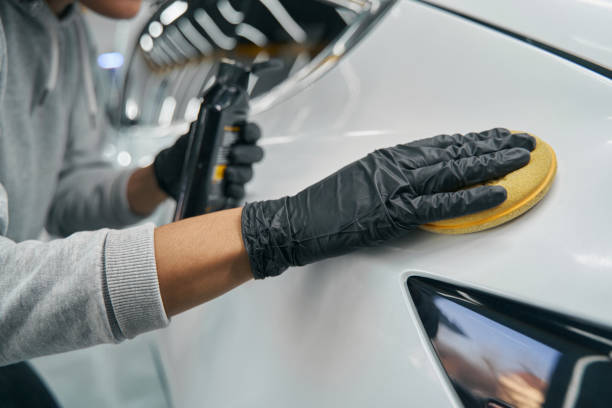Car waxing is a crucial step in maintaining your vehicle’s appearance and protecting its paintwork. While many car owners opt to wax their vehicles at home, certain common mistakes can compromise the results and potentially damage the car’s finish. This article outlines these pitfalls and offers expert advice to ensure your DIY car waxing efforts are both effective and safe.
At TRUSHYNE MOBILE DETAILING, we understand the intricacies of car care. Our experience has shown that avoiding these common mistakes can make a significant difference in the outcome of your car waxing endeavors.
Waxing Under Direct Sunlight
Applying wax in direct sunlight or on a hot surface can cause the wax to dry too quickly, leading to uneven application and difficulty in buffing. It’s advisable to wax your car in a shaded area or during cooler parts of the day to ensure optimal results.
Applying Wax on a Wet Surface
Waxing a car that hasn’t been thoroughly dried can prevent the wax from bonding properly to the paint. Ensure your vehicle is completely dry before applying wax to achieve a smooth and lasting finish.
Using a Dirty Applicator
Reusing applicators without proper cleaning can introduce dirt and debris onto the car’s surface, causing scratches. Always use clean, soft applicators and wash them after each use to maintain their effectiveness.
Over applying Wax
Applying too much wax doesn’t enhance shine or protection; instead, it makes the buffing process more labor-intensive and can leave residue. A thin, even layer is sufficient for effective protection and shine.
Using Low-Quality Wax
Not all waxes are created equal. Using a low-quality or inappropriate wax for your vehicle’s paint can lead to subpar results. Invest in a reputable wax product suitable for your car’s finish to ensure durability and shine.
Neglecting Surface Preparation
Failing to properly wash and decontaminate your car before waxing can trap dirt under the wax layer, leading to scratches and reduced effectiveness. Always wash and, if necessary, clay bar your vehicle before applying wax.
Ignoring Weather Conditions
Waxing your car just before it rains or in high humidity can hinder the wax’s ability to cure properly, reducing its protective qualities. Choose a dry, mild day for waxing to ensure the best results.
Conclusion
Avoiding these common mistakes can significantly improve the outcome of your at-home car waxing efforts. By paying attention to application conditions, using the right products, and preparing your vehicle properly, you can achieve a professional-looking finish that protects and enhances your car’s appearance.
FAQ
How often should I wax my car?
It’s generally recommended to wax your car every 3-4 months, but this can vary based on environmental factors and the type of wax used.
Can I wax my car if it’s slightly dirty?
No, waxing over dirt can cause scratches and prevent the wax from adhering properly. Always wash your car thoroughly before waxing.
Is it necessary to remove old wax before applying a new layer?
While not always necessary, removing old wax can help the new layer bond better and provide a more even finish.
Can I use household products like dish soap to wash my car before waxing?
It’s not recommended, as dish soap can strip away protective coatings. Use a car-specific shampoo to preserve your vehicle’s finish.






